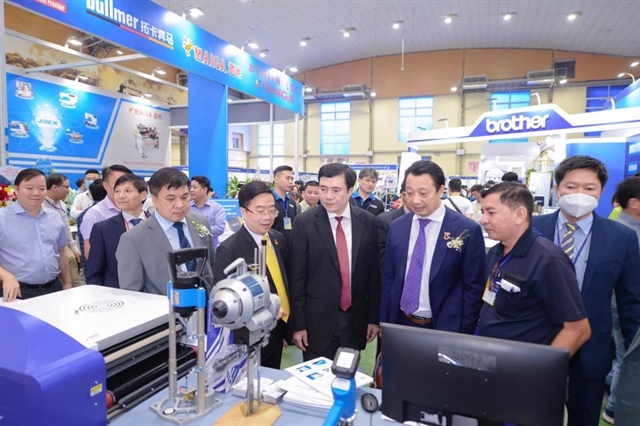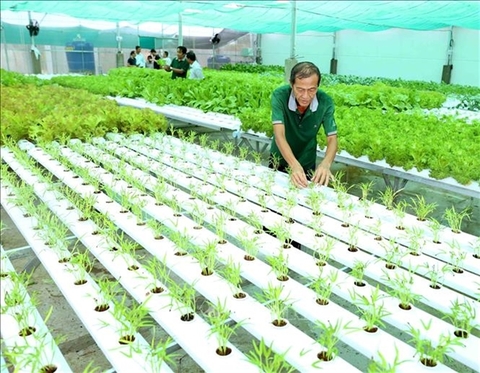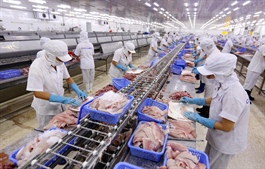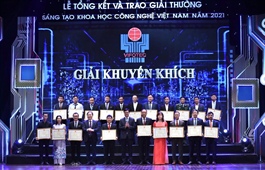HanoiTex 2022 provides development platform for textile industry
HanoiTex 2022 provides development platform for textile industry
Vietnam’s textile sector is on track to realize its export growth target of US$43 billion this year and maintain strong momentum in 2023.
The Vietnam Hanoi Textile & Garment Industry – Fabric & Garment Accessories Expo (HanoiTex 2022), officially opened on November 23 at the International Exhibition Center, is an ideal platform to boost the development of the local textile industry.

Delegates at the HanoiTex 2022. Photos: Khac Kien |
The event is jointly organized by the Vietnam National Textile-Garment Group (Vinatex), the Vietnam Chamber of Commerce and Industry (VCCI), and the Hong Kong-based CP Exhibition.
According to the organizer, the HanoiTex would take place until November 25 in an area of 4,000 square meters and draw the participation of 160 international exhibitors in eight countries and territories of China, Singapore, Turkey, South Korea, India, Indonesia, Vietnam, Hong Kong, and Taiwan.
At the expo, foreign exhibitors display machinery, spare parts, technologies, dyes, and chemicals of the textile and garment industry, while local firms would have a chance to seek partnerships with their international peers, including BSP, Chean-An, Dah Heer Industrial Company from Taiwan; Cixi Cam Machinery Company, Jiangsu YiYi New Material, KLF Textile (maintain China); Lenzing (Singapore), or Pidilite Industries (India).
Vice Minister of Industry and Trade Nguyen Sinh Nhat Tan, at the launching ceremony, noted textile and garment remain not only a critical industrial sector with the third-largest export turnover but also a key source of social welfare by creating jobs for millions of people at a higher-than-average salary.

Modern machinery and equipment are in display at the event. |
Bright outlook for Vietnam’s textile and garment
According to the Ministry of Industry and Trade, Vietnam’s textile and garment sector currently employs 2.5 million workers with an average salary of US$3,800 per year and generates an export turnover of $40 billion.
Tan, however, pointed out the low-added value of the sector as the majority of textile firms are still dependent on imported input materials, as well as the inability to engage in the upstream production processes in the supply chains with higher added value.
“Lower productivity compared to other countries in the region and limitation in the technological application are also issues of the sector,” Tan said.
Looking ahead, the Vice Minister called for the local textile and garment sector to continue integrating into the global supply chains, focusing on high-added-value processes, such as design, production of input materials, and distribution.
“HanoiTex, in this process, is a valuable opportunity for Vietnamese companies to access the most modern technologies and equipment, allowing them to identify the upcoming trend for future development. In addition, they also have the right platform to search for partners, credible suppliers and promote trade relations with countries in the region and the world,” he continued.
Sharing Tan’s view, the Chairman of Vinatex Le Tien Truong called for local companies to be more active in diversifying markets and gain a better understanding of new trends in the sector for sustainable development.
“Local companies should further broaden their horizons and adopt the best practice to contribute to the overall development of Vietnam’s textile and garment industry,” Truong added.
According to a report from the Vietnam Textile and Apparel Association (VITAS), the unfavorable global economic environment means growing difficulties for Vietnamese textile companies.
However, VITAS Chairman Vu Duc Giang expects the sector to realize its export growth target for this year and maintain strong momentum in 2023.
During the first ten months of 2022, Vietnam’s textile and garment companies reported a combined export turnover of US$38 billion, up 17.2%, putting the industry on track to hit the $ 43 billion target.
According to Giang, such a positive performance is thanks to Vietnam’s vast network of 15 free trade agreements (FTAs), which pave the way for Vietnamese products to access 66 countries and territories, including major markets in the US, EU, China, and South Korea.
“We expect the sector to continue overcoming difficulties and reach the export revenue of $45-47 billion in 2023,” Giang said.





















